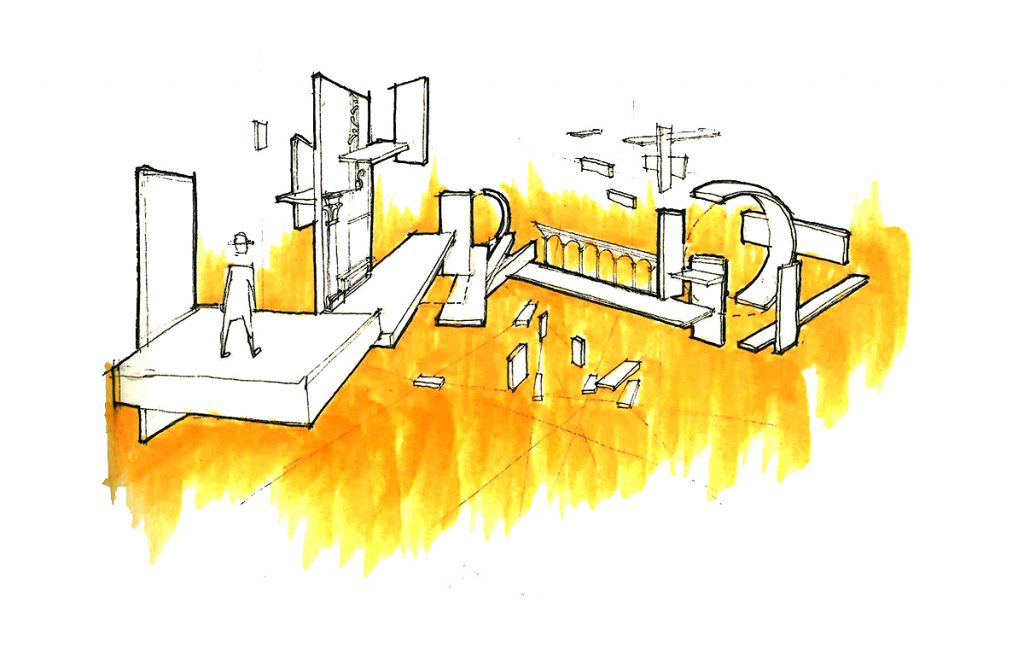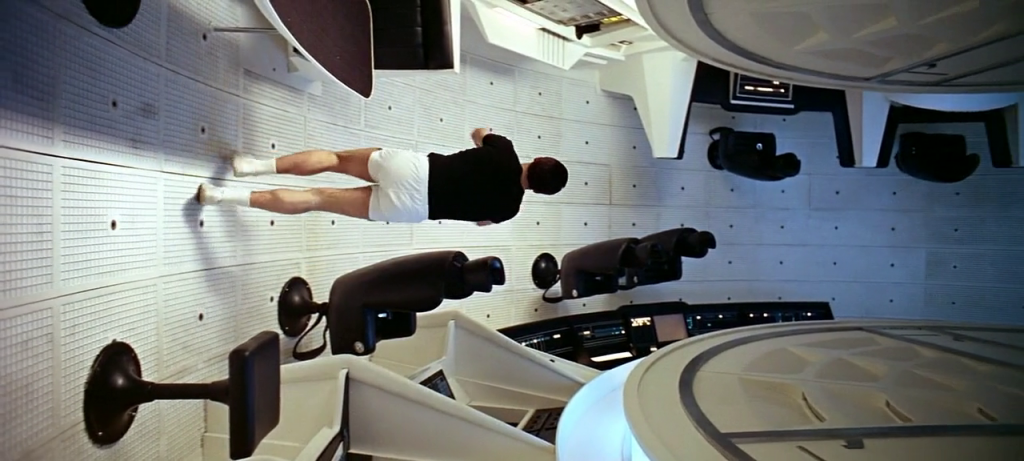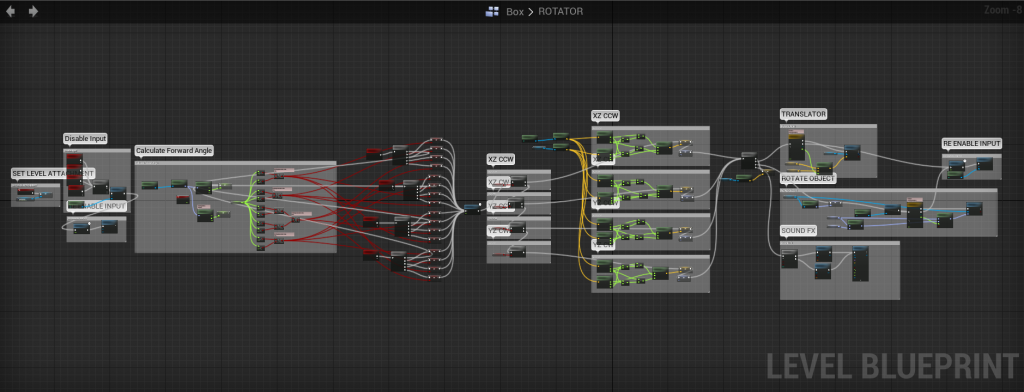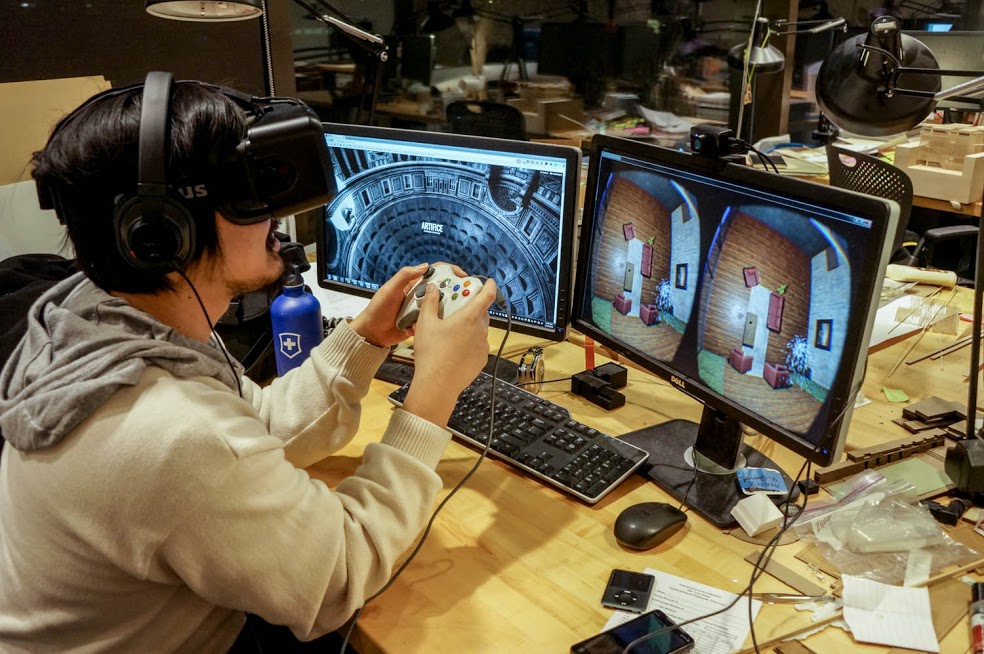Artifice
The Design and Development process of a prototypical ‘Eccentric‘ environment for an immersive architectural experience with Virtual Reality.
Task
A self-proposed Independent research/study credit from Yale School of Architecture. Tackling the utilization of Virtual Reality create novel architectural experiences.
-
Design
Virtual Reality
-
Client
Academic - Yale
-
Tools
Rhino3D, Unity, Unreal Engine
-
Team
Dionysus Cho, Anne Ma

Concepts.
Eccentric games employ spaciotemporal effects which give the player access to logics indigenous to digital environments. These logics often reference pop-physics theories and paradoxes such as those related to time travel, parallel realities, navigating multiple dimensions, folding time and space, quantum mechanics, probability engines, and the conflation of virtual and actual space.
Patrick Lemieux, Eccentric Spaces and Filmic Traces

Over the last few years, architecture is progressively moving into the digital age, if not already fully immersed in it. Within the framework of this evolution, there is potential to further the experience of architecture in the digital environment in two separate streams.
The first is a push towards hyper-realism in the form of photo-realistic render and walkthroughs or realistic role-playing experiences in gaming. The experience is grounded through the manipulation of realistic elements including physical material and texture emulation.
The other rift in reality is a manipulation of not only the spatial qualities of architecture, but also dimensional physics by which architecture can be experienced – factors like time and gravity. This opens up the architectural experience to new possibilities, creating temporal, ephemeral or even psychological effects and experiences that are entirely not feasible in the real world.
The virtual environment of gaming provides a very malleable foundation for which to develop this manipulation and create eccentric architectural experiences.
The virtual environment of gaming provides a very malleable foundation for which to develop this manipulation and create eccentric architectural experiences.
Precedents.
We first took an inventory of precedent media in film and gaming with ‘eccentric‘ spatial manipulation. Whether a manipulation of time or space, these examples illustrate the fluidity of architecture removed from the bounds of reality – an escape from the expectations of perspective and ground.
Ideations.
Each of us today possesses two bodies: the primitive body that a human being always possessed and the virtual body that has come into being with the spread of the media. The former seeks the beautiful light and fresh breeze found in nature. The other body which responds to the electronic environment, might be called a media-like body in search of information. The relationship between these two bodies is constantly shifting. We connect to architecture and the city through both of them.
Architects must assist in their re-integration; buildings and cities must provide for both the virtual body and the primitive one.
Toyo Ito, Architect
We then began ideating.
As typical architects, simple hand drawn sketches provide the starting point of generating concrete concepts of our interpretations.

The ideas focused on the concept of shifted planes or abstract surface – the delineation of floor and wall is no longer so clear when we can manipulate our perspective.


Rotations.
Developing physical models help us visualize these shifting spaces in 3D. Simple hand cut paper models give quick ideas of two concepts.
The first depicts a rotated gravity where we can flip the direction of gravity orthogonally. Conceptually, this refers to the rotation of the architecture around the user.
The second is a gravity that follows the user. As such, one could walk up a curved surface seamlessly (think Space Odyssey, right). This rotates the user to the normals of the surface they interact with.


Prototypes.
The initial inspiration of our studies came about from an interest in eccentric video games. Naturally, we moved from pen and paper into experimentations with game engines.
As architecture students without prior experience in game development, this required an exploration into various platforms. We experimented initially with Unity, but this proved challenging without programming experience (or significant time to learn it).
We then moved on to Unreal Engine. The ability to quickly import .fbx files from Rhino3D, apply textures and lighting, and view photorealistic spaces in the VR headset (the then beta version of the Oculus Rift) was amazing. The visual nature of the IDE, and its similarity to familiar 3D softwares (Rhino3D, 3DSMax), made it our platform of choice moving forward.
The initial prototype was a simple four-sided loop (right), much like the inside of a cube.
This illustrated our goal in an incredible simple space.

I took the opportunity to dig into Unreal’s Blueprint scripting language to develop the interactions, mainly the manipulation of the space around the user.
This involved determining the user’s position and rotation, then, given controller input (typical gamepad, since VR controllers did not yet exist), the world would rotate orthogonally around the user in the specified direction.
This acted to simulate the change in gravitational directions. (Since I could not figure out how to change gravity direction, if possible at all.)


New Realities.
From the initial loop of the inner cube, designs evolved three themes.
The interpretations of living spaces within rotatable cubes (above), infinitely looping staircases (left), and re-experiencing existing architecture (Frank Lloyd Wright’s Johnson Wax Headquarters in Wisconsin from NYT, below).
This provided multiple readings and applications of eccentricity. The ability to create new versions of familiar spaces introduces a re-imagining of architectural elements like surfaces. The creation of novel spaces allowed by this eccentricity creates completely new experiences. And the re-experiencing of existing space brings new readings and perspectives of known spaces.


In addition to the power of the Gaming Engine, experiencing this in Virtual Reality made the project incredibly worthwhile. Since this was our first experience with VR at all, it was an incredible opportunity to utilize this new(ly available) technology.

Final.
The final presentation culminated in a video presentation of our work alongside a demonstration of our eccentric experience in virtual reality with the Oculus Rift headset.
This was presented to a panel of professors/architects affiliated with Yale School of Architecture, including our advisor, Mark Foster Gage, and Dean Robert A.M. Stern.
Putting this project together, from proposal to presentation, allowed us to get firsthand experience with developing and testing our ideas in Virtual Reality. This was especially novel at the time, and timely since our school labs had just acquired one of the newly available beta models of the Oculus Rift.
This also spurred a lifelong interest in VR and gaming experiences, as well as a deeper interest in programming. This, looking back, led me to dig deeper into understanding the technical components of VR programming, with further studies in Computer Science.
